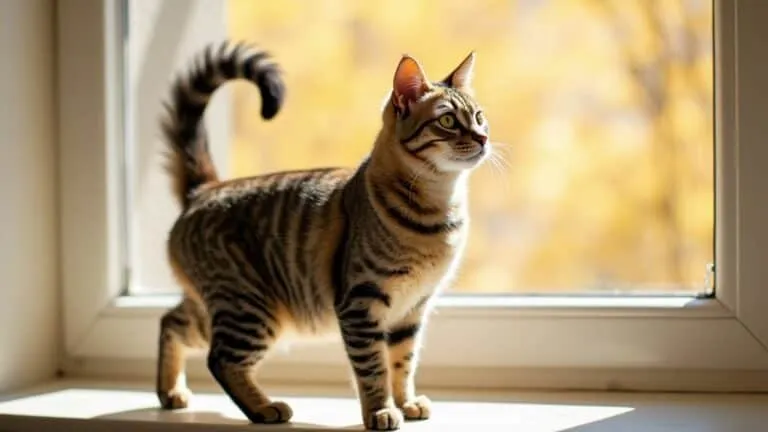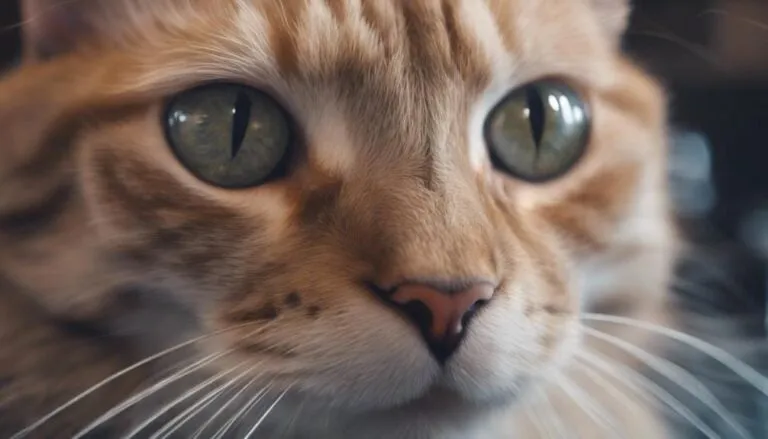The Best Fluffy Pancakes recipe you will fall in love with. Full of tips and tricks to help you make the best pancakes.

Welcome to the mesmerizing realm of cat tongues, where these enigmatic organs hold secrets waiting to be unraveled. Just like a hidden treasure chest, a cat's tongue holds a wealth of information about their grooming habits, eating and drinking techniques, and their intricate ways of exploring the world around them.
So, prepare to embark on a fascinating journey as we venture into the depths of this captivating subject, uncovering the mysteries that lie within the fascinating world of cat tongues.
Key Takeaways
- Cats use their tongues for various functions, including grooming, eating and drinking, exploring the environment, and finding comfort and relaxation.
- Grooming behavior can serve as a form of social bonding between cats and is learned from their mothers.
- The unique texture of a cat's tongue, with its papillae, helps them clean their fur, grip food, and defy gravity while drinking.
- Cats may lick non-food objects to explore their environment, and over-grooming can be a sign of underlying medical issues.
Functions of a Cat's Tongue
The functions of a cat's tongue are multifaceted and crucial to their overall well-being and daily activities. Evolutionary adaptations of cat tongues have enabled them to perform various tasks, allowing us to better understand their behavior through tongue examination.
Cats use their tongue for grooming, keeping themselves clean and cool. The papillae on their tongue act like tiny hooks, helping to detangle their fur and transfer saliva from their mouth to their fur. This saliva, along with the rough texture of their tongue, acts as a natural cooling system, lowering their body temperature.
Additionally, their tongue plays a significant role in eating and drinking by helping them grip their food, deform tissues, and scrape off food particles.
Lastly, their tongue is essential for exploring their environment, as they use their senses, including taste, to understand and claim their territory.
Grooming as Social Bonding
Grooming serves as a vital form of social bonding among cats, facilitating communication and building relationships. Through grooming, cats establish a sense of trust and familiarity with one another. This grooming ritual involves specific cat grooming techniques, such as licking and nibbling each other's fur.
The act of allogrooming, or mutual grooming, is a form of caregiving that strengthens the bond between cats. It's a way for cats to show affection and care for one another. Grooming also helps cats maintain a clean and healthy coat, indicating their well-being and contentment.
Observing cats engaging in this bonding ritual can evoke feelings of warmth and tenderness, as it showcases the deep connection and social nature of these fascinating creatures.
Tongue's Role in Eating and Drinking
After exploring the significance of grooming as a form of social bonding among cats, let's now delve into the fascinating role of a cat's tongue in eating and drinking.
A cat's tongue plays a crucial role in enhancing taste perception and maintaining oral hygiene. When it comes to eating, the tongue is used to grip food and the sharp tip aids in tissue deformation and penetration into meat. Additionally, the tongue's rough texture helps scrape food particles off surfaces.
In terms of drinking, cats use the tip of their tongue to pull water upward, defying gravity. This efficient drinking technique ensures that they stay hydrated. Furthermore, the tongue's cleaning action helps maintain oral hygiene by removing debris and bacteria from their teeth and gums.
Understanding the multifunctional role of a cat's tongue allows us to better serve our feline companions by providing them with a satisfying and hygienic dining experience.
Tongue's Role in Exploring the Environment
To explore their environment, cats utilize their tongue as a sensory organ, using taste and tactile sensations to gain information about their surroundings. Their tongues play a crucial role in this exploration process.
Here are some key points to consider:
- Cats have functional bitter taste receptors. These receptors may help them detect potential dangers or poisonous substances in their environment.
- Cats may lick non-food objects as a means of exploration. This behavior allows them to gather information about unfamiliar objects or areas.
- Poor tasting capabilities in cats may explain why they often resort to licking non-food objects for exploration purposes.
Understanding the role of a cat's tongue in exploring the environment sheds light on their remarkable ability to navigate and adapt to their surroundings. By utilizing their sense of taste and tactile sensations, cats are able to gather valuable information and claim their territory.
Grooming for Comfort and Relaxation
The act of grooming serves as a therapeutic practice for cats, providing them with comfort and relaxation. Grooming isn't just about maintaining a clean and healthy coat; it also serves as a means for self-soothing. Cats often use grooming as a way to cope with stress and anxiety, using their tongues to groom themselves in a repetitive and rhythmic manner. This repetitive action helps them calm down and find comfort in the familiar motion.
However, it's important to note that over-grooming can be a sign of an underlying medical condition. If you observe excessive grooming, such as bald spots or skin irritations, it's recommended to take your cat to the vet for a thorough examination. Medical conditions related to over-grooming may include allergies, skin infections, or even behavioral issues.
Ensuring your cat's comfort and relaxation through grooming requires attentiveness and proper care.
Importance of a Healthy Cat Coat
A healthy cat coat is essential for maintaining the overall well-being and optimal functioning of a feline's body. Regular grooming plays a crucial role in maintaining a healthy cat coat, preventing matting and skin issues. By using grooming tools and techniques, such as brushes and combs, you can effectively remove dirt, debris, and loose hair from your cat's coat.
This not only keeps their fur clean but also stimulates blood circulation and distributes natural oils, resulting in a healthier and shinier coat. Additionally, diet plays a significant role in promoting a healthy cat coat. Providing a balanced and nutritious diet ensures that your cat receives the necessary vitamins and minerals for maintaining a strong and lustrous coat.
The Unique Texture of Cat Tongues
Cat tongues possess a unique texture that serves multiple functions in their daily activities. These evolutionary adaptations are essential for their sensory capabilities.
The surface of a cat's tongue is covered in tiny, backward-facing papillae, giving it a rough, sandpaper-like texture. These papillae serve several purposes. Firstly, they aid in grooming by detangling fur and transferring saliva from the mouth to the fur, helping to keep the cat clean and cool.
Secondly, they play a crucial role in eating and drinking by helping the cat grip their food, deform tissues, and scrape off food particles.
Finally, the unique texture of the cat's tongue assists in exploring the environment, as cats use their tongues to taste and claim territory.
Understanding the unique texture of cat tongues is vital for providing the care and attention that these fascinating creatures deserve.
Evolutionary Adaptations of Cat Tongues
With their rough, sandpaper-like texture, cat tongues have undergone evolutionary adaptations that enable them to perform various functions essential for their survival and well-being. These evolutionary advantages and sensory adaptations have allowed cats to thrive in their environments and excel in activities such as grooming, eating, drinking, and exploring.
Some of the key evolutionary advantages and sensory adaptations of cat tongues include:
- Enhanced grooming capabilities: The papillae on the tongue help cats keep themselves clean, detangle their fur, and transfer saliva from the mouth to the fur, which aids in lowering their body temperature.
- Improved eating and drinking abilities: The sharp tip of the tongue assists with tissue deformation and penetration into meat, while also allowing cats to easily scrape food particles off surfaces. Additionally, their tongue's unique structure enables them to defy gravity while drinking and pull water upward.
- Heightened sensory perception: Cats use their tongues to explore their environment and claim their territory. The presence of functional bitter taste receptors allows them to potentially detect poison, while licking non-food objects aids in understanding their surroundings.
These evolutionary adaptations have undoubtedly contributed to the remarkable survival and success of cats throughout history.
Understanding Cat Behavior Through Tongue Examination
By examining a cat's tongue, researchers can gain valuable insights into their behavior and communication patterns. The role of the tongue in communication is significant, as cats use it to convey various messages to other cats and humans.
Grooming behavior in different cat breeds can also be observed through tongue examination. Each breed may exhibit unique grooming techniques and frequencies, which can provide information about their social interactions and level of self-maintenance. For example, long-haired breeds may require more grooming to prevent matting, while short-haired breeds may have a different grooming routine.
Understanding these grooming behaviors can help us better understand the social dynamics and needs of different cat breeds, allowing us to provide appropriate care and support for their overall well-being.
Frequently Asked Questions
How Often Should I Groom My Cat to Maintain a Healthy Coat?
To maintain a healthy coat, groom your cat regularly. The frequency depends on the breed. Regular grooming is important for overall cat health, keeping their fur clean, detangled, and reducing the risk of hairballs.
Can Cats Taste Different Flavors With Their Tongues?
Yes, cat tongues can detect different textures and temperatures. They use their tongues for grooming, hunting, and exploring their environment. The papillae on their tongues help with these functions.
What Are Some Signs That My Cat Is Stressed or Anxious?
If your cat is stressed or anxious, look for signs such as excessive grooming, hiding, aggression, or changes in appetite. To calm them, create a safe and quiet environment, provide hiding spots, and consider using pheromone sprays or diffusers.
Are There Any Specific Objects That Cats Are More Likely to Lick to Explore Their Environment?
Licking behavior in cats is influenced by their environment. It serves as a way to explore and claim territory. Cats may lick objects to gather information about their surroundings. Through licking, cats communicate messages of familiarity and relatedness.
How Can I Help Prevent My Cat From Over-Grooming?
To prevent your cat from over-grooming, try using cat grooming tools like brushes or combs. Distract your cat with toys or playtime to redirect their grooming behavior. If the problem persists, consult a veterinarian for further guidance.
Conclusion
In conclusion, the multifunctional and versatile nature of a cat's tongue is truly awe-inspiring. From grooming to eating, drinking, and exploring, this remarkable organ is an essential tool for a cat's survival and well-being.
Like a finely tuned instrument, the cat's tongue delicately performs its various tasks, weaving a tapestry of sensory experiences. It's a symphony of adaptation, a brushstroke painting the intricate details of feline behavior.
Unlocking the secrets of the cat tongue allows us to better understand and appreciate the fascinating world of our feline companions.








